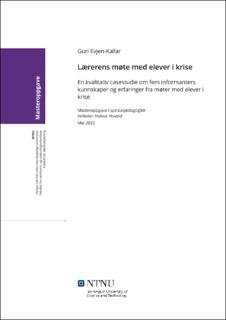| dc.description.abstract | Temaet for denne studien er lærerens møte med elever i krise. Formålet med studien har vært å innhente erfaringer og kunnskap fra erfarne lærere, spesialpedagoger og andre relevante personer, som enten jobber- eller har jobbet mye med elever som har opplevd å stå i kriser. Studiens fokus har vært å finne ut av hva skolen (med fokus på læreren) kan bidra med i slike situasjoner - altså hvordan elever som opplever kriser kan møtes og ivaretas generelt i skolehverdagen.
Studiens problemstilling er som følger: «Hvordan møter læreren elever i krise?» Denne problemstillingen har blitt undersøkt gjennom en casestudie med en kvalitativ tilnærming. Jeg har gjennomført fire dybdeintervjuer med fem informanter som representerer både barne- og ungdomstrinnet. Informantene har ulike bakgrunner –lærer, spesialpedagog, sosiallærer, men felles for dem alle er at de har erfaringer med ulike elevkriser.
Etter det tematiske analyse- og tolkningsarbeidet ble studiens empiri til slutt delt inn i tre hovedkategorier: elever i krise, prinsipper for god ivaretakelse av elever i krise og konkrete tiltak til fremtidens støttespillere rundt elever i krise. Gjennom disse kategoriene blir vi kjent med informantenes kunnskap, perspektiver og erfaringer fra praksisfeltet, og de har klare formeninger om hvordan elever i krise bør møtes i skolen. Det er mange sentrale funn i denne studien. Først og fremst er informantene opptatt av at det er elevene selv som må definere om de er i krise. For å få til en god oppfølging er informantene også mer opptatt av å ta utgangspunkt i elevens opplevelser, følelser og tanker rundt situasjonen – som de blir kjent med gjennom en god relasjon, enn å følge en beredskapsplan med x antall punkter. De stiller også en del krav til de lærerne som skal følge opp elevene – de må være trygge, åpne og lyttende, og de må også kunne samarbeide på flere plan – skole-hjem, innad i teamet/kollegiet, samt med eksterne instanser og organisasjoner. Informantene kommer også med eksempler på tiltak som kan brukes overfor elever i krise - både sosiale og pedagogiske.
Selv om jeg anser disse funnene som gode, er det viktig å fremheve at de ikke kan brukes som et fasitsvar i møte med elever i krise. Det er mye man må ta hensyn til i slike møter. Elevene er forskjellige, krisene er forskjellige, relasjonene er forskjellige, nettverket rundt er forskjellig og så videre. Derfor vil jeg heller si at en god praksis kan være å etterstrebe at man håndterer elevens krisesituasjon ut ifra elevens ståsted, og at man kanskje kan bruke funnene jeg har gjort i denne studien som inspirasjon, i prosessen. | |
| dc.description.abstract | The teacher's interaction with pupils in crisis is the focus of this research. The goal of this study was to obtain experiences and knowledge from experienced teachers, special educators, and other relevant professionals who either work-, or have collaborated with pupils who have faced crises. The study's goal was to find out what the school (with an emphasis on the teacher) can do in such situations, i.e., how pupils who experiencing crises can be met and be cared for in general during their school day.
"How does the teacher meet pupils in crisis?" is the study's problem statement. A case study with a qualitative approach was used to analyze this topic. I did four in-depth interviews with five informants, who represented both primary- and junior high school. The informants have various backgrounds (teacher, special educator, welfare teacher), but they all have experience with various pupil crises.
The study's empirical findings were finally separated into three primary categories, after the thematic analysis and interpretation work: pupils in crisis, principles for appropriate care of pupils in crisis, and concrete strategies for future supporters around pupils in crisis. We learn about the informants' knowledge, viewpoints, and experiences from the field of practice through these categories, and they have distinct ideas on how pupils in crisis should be met in school. This study contains a number of significant discoveries. The informants are clearly on, first and foremost, that it is up to the pupils to determine whether they are in crisis. The informants are also more focused with starting from the pupil's experiences, feelings, and views about the problem - which they become familiar with through a good relationship - than following a contingency plan with x number of points, to accomplish a good follow-up. They also have specific requirements for teachers who will follow up the students - they must be safe, open, and listening, as well as be able to collaborate on multiple levels - including school-home, inside the team/college, and with external agencies and organizations. The informants also provide examples of social and pedagogical interventions, which can be used against pupils in crisis.
Although these findings are positive, it is crucial to note that they cannot be utilized as a conclusive response in meetings with pupils in crisis. In such encounters, there is a lot to think about. Pupils differ, as do crises, relationships, and the network that surrounds them. As a result, I would rather suggest that a good practice is to try to handle a pupil's crisis from the pupil's perspective, and that one may utilize the findings of this study as inspiration in the process. | |
